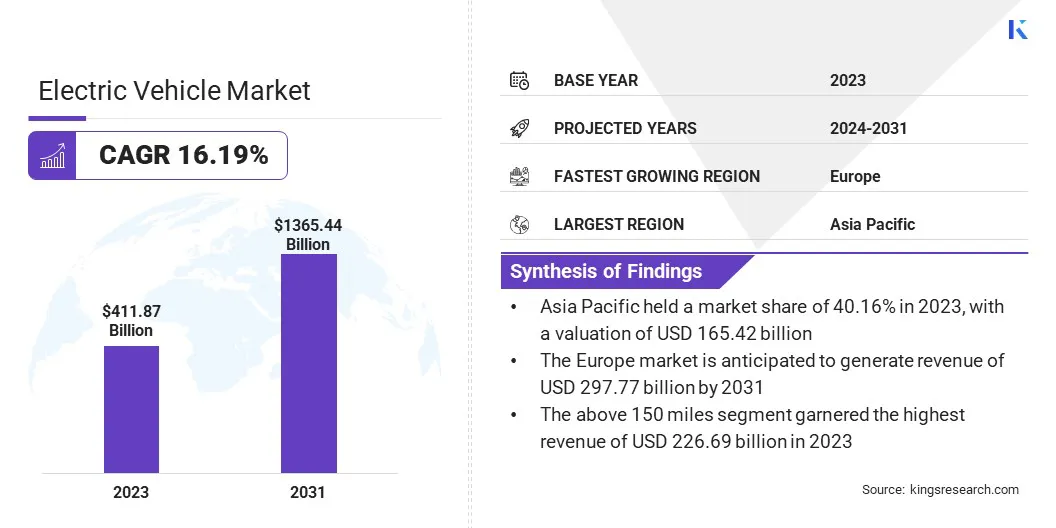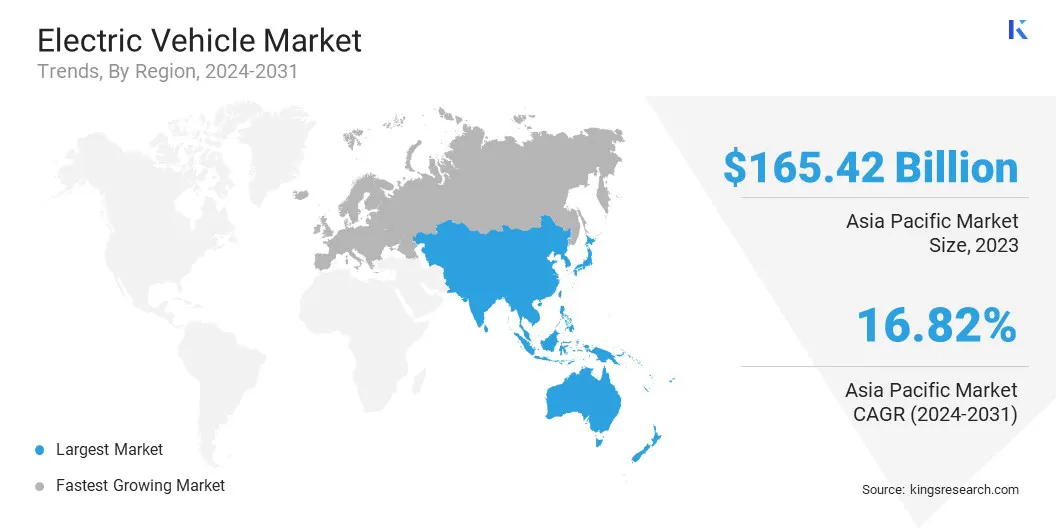Electric Vehicle Market Size
The global Electric Vehicle Market size was valued at USD 411.87 billion in 2023 and is projected to reach USD 1,365.44 billion by 2031, growing at a CAGR of 16.19% from 2024 to 2031. In the scope of work, the report includes products offered by companies such as BMW AG, Mercedes-Benz Group AG, Honda Motor Co., Ltd., Toyota Motor Sales, U.S.A., Inc., Stellantis NV, Volkswagen AG, Tesla, BYD Company Ltd, Hyundai Motor Company, Ford Motor Company and Others.
The market is witnessing exponential growth mainly due to stringent government regulations aimed at reducing carbon emissions and promoting sustainable transportation solutions. Countries worldwide are implementing policies to incentivize the adoption of electric vehicles (EVs), such as subsidies, tax benefits, and infrastructure development initiatives.
- For instance, various nations such as Norway and China have set ambitious targets to phase out internal combustion engine vehicles in favor of EVs, which is fueling market growth.
Increasing environmental awareness among consumers, coupled with advancements in battery technology, has led to an increase in demand for EVs. Additionally, declining costs of lithium-ion batteries, which are essential components of EVs, have made electric vehicles more affordable and attractive to a broader consumer base.
- For instance, Tesla's innovative technology in producing high-performance EVs at competitive prices has spurred market growth and innovation, prompting other automakers to invest in electric mobility.
Furthermore, the growing focus on renewable energy sources has led to the development of charging infrastructure powered by clean energy sources, thereby driving EV adoption. Collaborations between governments, automakers, and technology firms to expand charging networks have mitigated concerns regarding the limited range of electric vehicles, thereby instilling increased confidence among consumers in the viability of EVs.
The electric vehicle (EV) market encompasses the production, sale, and utilization of vehicles powered primarily by electric propulsion systems, including (BEVs), (PHEVs), and (FCEVs). It involves various stakeholders, including automotive manufacturers, suppliers, charging infrastructure providers, and government regulators, working collectively to promote the adoption of clean and sustainable transportation solutions.

Analyst’s Review
The electric vehicle market continues to exhibit remarkable growth, mainly driven by advancements in battery technology, government initiatives promoting clean energy, and shifting consumer preferences toward eco-friendly transportation.
While challenges such as infrastructure development and range limitations persist, the market's growth trajectory remains positive, fueled by innovation and regulatory support. The emergence of new players, strategic collaborations, and increasing investments in R&D are projected to support the expansion of the electric vehicle market over the forecast period.
Electric Vehicle Market Growth Factors
Government incentives have played a pivotal role in propelling the growth of the electric vehicle (EV) market globally. By offering tax breaks, subsidies, and other incentives, governments have aimed at promoting the utilization of EVs, thereby stimulating demand. This approach is boosting the demand for EVs financially while aligning with government initiatives to foster sustainability through the promotion of cleaner transportation options.
- For instance, in 2022, the global sale of EVs surged by 75%, surpassing 2 million units, indicating the significant impact of government incentives on market expansion. Such policies offer benefits to individual consumers and contribute to the effort of reducing carbon emissions on a larger scale, thereby addressing environmental concerns and mitigating climate change.
Additionally, stricter emission regulations are compelling automobile manufacturers to accelerate their EV development efforts. With governments worldwide implementing stringent regulations on greenhouse gas emissions from vehicles, automobile manufacturers are investing heavily in EV technologies to meet regulatory requirements.
This regulatory initiative is fostering innovation in the automotive industry, driving advancements in battery technology, vehicle design, and overall sustainability practices. As a result, automakers are increasing their EV production and expanding their electric vehicle portfolios to cater to the growing demand for eco-friendly transportation.
However, the market faces significant challenges due to limitations in sourcing critical minerals such as lithium and cobalt. The surge in demand for EVs has raised concerns regarding sustainable sourcing practices and potential price fluctuations.
Ensuring a stable and ethical supply chain for these materials is imperative for manufacturers to sustain the growth of the EV market. Innovations in recycling and alternative materials, coupled with strategic partnerships with mining companies, are essential to mitigate these challenges and ensure the long-term viability of EV production.
Electric Vehicle Market Trends
Electric vehicle manufacturers are adopting the diversification of EV models by expanding their offerings beyond traditional compact cars to include SUVs, trucks, and luxury vehicles. This diversification strategy aims to cater to a wider range of consumer preferences and lifestyles, thereby increasing EV adoption rates.
- For instance, Tesla's introduction of the Model Y, an electric SUV, has garnered widespread acclaim and contributed significantly to the brand's market dominance. Moreover, Audi, BMW, and Mercedes-Benz have launched electric SUVs to capitalize on the growing demand for electric crossovers and SUVs, thereby reflecting the industry's shift toward diversification.
Furthermore, fuel cell electric vehicles (FCEVs) are gaining popularity, alongside battery electric vehicles (BEVs), particularly in specific commercial applications. FCEVs offer faster refueling times and longer driving ranges, making them suitable for fleet operations and long-distance travel. Companies including Toyota and Hyundai are leading the development of FCEVs, with models such as the Toyota Mirai and Hyundai Nexo gaining traction in regions with well-established hydrogen infrastructure.
Moreover, there is a notable focus on electrifying heavy-duty vehicles, such as buses and trucks, to reduce emissions in the transportation sector. Electric buses, in particular, have experienced significant growth, with global registrations witnessing a 23% increase between 2019 and 2023. Cities worldwide are increasingly adopting electric buses to improve air quality and reduce noise pollution.
- For instance, Shenzhen, China, operates the world's largest fleet of electric buses, demonstrating the feasibility and scalability of electrifying public transportation. Additionally, companies such as Tesla and Nikola Corporation are developing electric trucks with the potential to revolutionize freight transportation by offering zero-emission alternatives to conventional diesel trucks.
Segmentation Analysis
The global electric vehicle market is segmented based on vehicle type, range, propulsion type, and geography.
By Vehicle Type
Based on vehicle type, the market is bifurcated into light duty vehicles and heavy duty vehicles. The light duty vehicles segment led the market in 2023 with a share of 93.36%.
Advancements in battery technology have enhanced the performance and range of light-duty EVs, making them increasingly appealing to consumers for daily commuting and commercial purposes. Furthermore, government incentives and subsidies often target light-duty vehicles, making EV ownership financially more attractive compared to conventional vehicles.
Additionally, the growing consumer awareness regarding environmental sustainability is driving demand for eco-friendly transportation solutions, which is boosting the adoption of light-duty EVs. Moreover, the availability of charging infrastructure, particularly for residential and urban locations, is enhancing the convenience of owning light-duty electric vehicles, thereby contributing to their leading position in the global market.
By Range
Based on range, the market is divided into up to 150 miles and above 150 miles. The above 150 miles segment garnered the highest revenue of USD 226.69 billion in 2023.
Technological advancements in battery optimization have significantly extended the range of EVs, making them convenient for longer-distance travel. Additionally, the above 150 miles range segment often includes premium and higher-priced EV models, thereby contributing to higher revenue generation.
Furthermore, the increasing availability of fast-charging infrastructure has facilitated convenient long-distance travel for EVs, thereby bolstering the demand for vehicles with extended ranges.
By Propulsion Type
Based on propulsion type, the market is categorized into battery electric vehicles (BEV), fuel cell electric vehicles (FCEV), hybrid electric vehicles (HEV), and plug-in hybrid vehicles (PHEV). The fuel cell electric vehicles segment is projected to record a robust CAGR of 18.95% over 2024-2031.
FCEVs, which are powered by hydrogen fuel cells, offer distinct advantages such as faster refueling times and enhanced performance, which makes them particularly suitable for specific commercial applications and long-distance travel.
Government incentives and subsidies targeting hydrogen infrastructure development and FCEV adoption are further supporting the growth of the segment. Additionally, advancements in hydrogen production, storage, and distribution technologies contribute to the viability and scalability of FCEVs, impelling the demand for fuel cell electric vehicles.
Electric Vehicle Market Regional Analysis
Based on region, the global electric vehicle market is classified into North America, Europe, Asia-Pacific, MEA, and Latin America.

The Asia Pacific Electric Vehicle Market share stood around 40.16% in 2023 in the global market, with a valuation of USD 165.42 billion. Government policies promoting clean transportation initiatives, coupled with escalating fuel prices, serve as the main factors driving regional market growth.
Moreover, the presence of large-scale EV manufacturing companies such as BYD in China has bolstered the country's robust domestic EV supply chain. This presence is further contributing to the notable market expansion, facilitating increased production, and fostering greater adoption of electric vehicles.
Strong emphasis on affordability, particularly evident in the soaring demand for electric two-wheelers and lower-priced electric cars, is fostering regional market expansion. This aligns with the region's vast consumer base and economic dynamics, prompting manufacturers to prioritize cost-effective EV solutions to cater to diverse market segments. Moreover, the region is witnessing a notable surge in local battery production, aimed at reducing reliance on imports and fostering self-sufficiency in the EV ecosystem.
The Europe electric vehicle market is anticipated to generate revenue of USD 297.77 billion by 2031. Stringent emission regulations promoting cleaner transportation solutions are fueling regional industry progress. Government subsidies and investments in charging infrastructure further bolster the progress of the European EV market, thereby creating an environment conducive to the widespread adoption of electric vehicles.
Notably, established companies such as Volkswagen, BMW, and Mercedes-Benz are actively transitioning their portfolios toward EVs. Additionally, active efforts of the EU to develop a circular economy for EV batteries, which emphasize recycling and reuse to minimize environmental impact and ensure sustainable battery supply chains, are projected to aid domestic market growth.
Competitive Landscape
The global electric vehicle market report will provide valuable insight with an emphasis on the fragmented nature of the industry. Prominent players are focusing on several key business strategies such as partnerships, mergers and acquisitions, product innovations, and joint ventures to expand their product portfolio and increase their market shares across different regions.
Companies are adopting lucrative measures including broadening their range of services, allocating resources to research and development (R&D), establishing state-of-the-art service delivery centers, and streamlining their service delivery processes, to gain a strong foothold in the market.
List of Key Companies in Electric Vehicle Market
- BMW AG
- Mercedes-Benz Group AG
- Honda Motor Co., Ltd.
- Toyota Motor Sales, U.S.A., Inc.
- Stellantis NV
- Volkswagen AG
- Tesla
- BYD Company Ltd
- Hyundai Motor Company
- Ford Motor Company
Key Industry Developments
- April 2024 (Expansion) – Stellantis NV commenced production of eDCT (electrified dual-clutch transmission) with an annual capacity of 600,000 units. This milestone marks a significant achievement within the scope of the ongoing €240 million overhaul of the renowned Italian facility, which has been rebranded as the Mirafiori Automotive Park 2030.
The Global Electric Vehicle Market is Segmented as:
By Vehicle Type
- Light Duty Vehicles
- Heavy Duty Vehicles
By Range
- Up to 150 Miles
- Above 150 Miles
By Propulsion Type
- Battery Electric Vehicles (BEV)
- Fuel Cell Electric Vehicle (FCEV)
- Hybrid Electric Vehicle (HEV)
- Plug-in Hybrids Vehicles (PHEV)
By Region
- North America
- Europe
- France
- U.K.
- Spain
- Germany
- Italy
- Russia
- Rest of Europe
- Asia-Pacific
- China
- Japan
- India
- South Korea
- Rest of Asia-Pacific
- Middle East & Africa
- GCC
- North Africa
- South Africa
- Rest of Middle East & Africa
- Latin America
- Brazil
- Argentina
- Rest of Latin America


